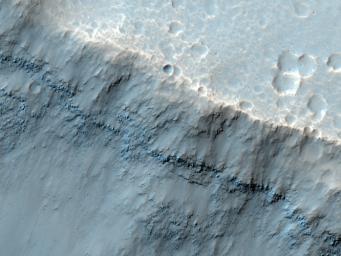
|
Mesas in Aureum Chaos
- Click the image above for a larger view
- Full-Res JPEG (800 x 600) (82.5 kB)
- Full-Res TIFF (800 x 600) (1.4 MB)
Caption:
This image reveals meter-scale (yard-scale) surface textures of mesas and knobs in the Aureum Chaos region of Mars. Aureum Chaos is a wide region of plateaus, mesas, and knobs. The High Resolution Imaging Science Experiment (HiRISE) camera on NASA's Mars Reconnaissance Orbiter recorded this image on March 2, 2010.
Most of the rocks in this area appear to have formed originally as laterally continuous layers through volcanic or sedimentary processes. Loss of groundwater or ground ice could have then caused the ground to collapse, forming the current surface features of deep valleys and isolated hills with sloped faces. Subtle layering of these rocks can be observed along the slope face seen here, jutting out from under a mantle of surface sediments. Also present along many slopes are dark-toned, discontinuous lineations. These are tracks left behind by boulders that rolled down the slopes.
This image covers a swath of ground about 1 kilometer (about two-thirds of a mile) wide. It is a portion of HiRISE observation ESP_016869_1775, which is centered at 2.45 degrees south latitude, 332.15 degrees east longitude. The season on Mars is southern-hemisphere autumn. Other image products from this observation are available at http://hirise.lpl.arizona.edu/ESP_016869_1775 .
Background Info:
The target for this HiRISE observation was a suggestion submitted by James Secosky through the camera team's HiWish public-suggestion program. For more information about how to submit target suggestions, see http://uahirise.org/hiwish/ .
Color images from HiRISE combine information from detectors with three different color filters: red, infrared, and blue-green. Thus they include information from part of the spectrum human eyes cannot see and are not true color as the eye would see. The resulting false color helps to show differences among surface materials.
The University of Arizona, Tucson, operates the HiRISE camera, which was built by Ball Aerospace & Technologies Corp., Boulder, Colo. NASA's Jet Propulsion Laboratory, a division of the California Institute of Technology, Pasadena, manages the Mars Reconnaissance Orbiter for the NASA Science Mission Directorate, Washington. Lockheed Martin Space Systems, Denver, built the spacecraft.
Cataloging Keywords:
| Name | Value | Additional Values |
|---|---|---|
| Target | Mars | |
| System | ||
| Target Type | Planet | |
| Mission | Mars Reconnaissance Orbiter (MRO) | |
| Instrument Host | Mars Reconnaissance Orbiter | |
| Host Type | Orbiter | |
| Instrument | High Resolution Imaging Science Experiment (HiRISE) | |
| Detector | ||
| Extra Keywords | Color, Infrared, Volcano, Water | |
| Acquisition Date | ||
| Release Date | 2010-03-31 | |
| Date in Caption | 2010-03-02 | |
| Image Credit | NASA/JPL-Caltech/University of Arizona | |
| Source | photojournal.jpl.nasa.gov/catalog/PIA12991 | |
| Identifier | PIA12991 | |
